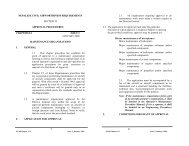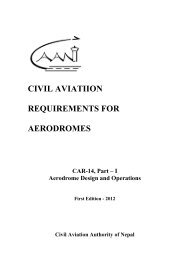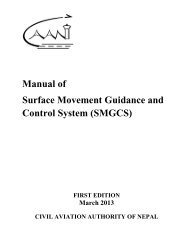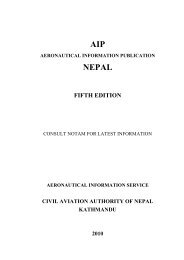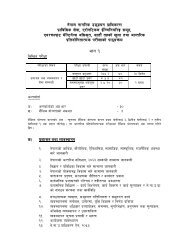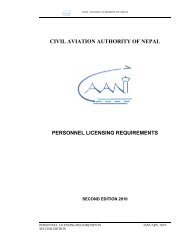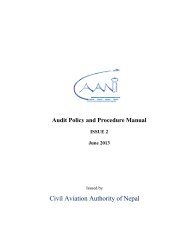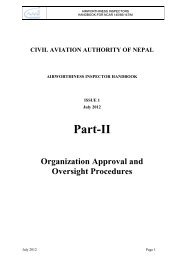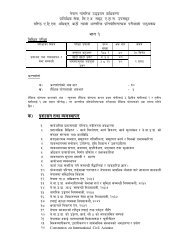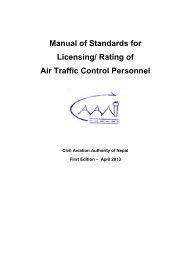Aerodrome Certification Regulations, 2061 - Civil Aviation Authority ...
Aerodrome Certification Regulations, 2061 - Civil Aviation Authority ...
Aerodrome Certification Regulations, 2061 - Civil Aviation Authority ...
You also want an ePaper? Increase the reach of your titles
YUMPU automatically turns print PDFs into web optimized ePapers that Google loves.
<strong>Aerodrome</strong> <strong>Certification</strong> Regulation <strong>2061</strong>, First Amend - 2063<strong>Civil</strong> <strong>Aviation</strong> <strong>Authority</strong> of Nepal<strong>Aerodrome</strong> <strong>Certification</strong> Regulation - <strong>2061</strong> B.S (2004 A.D)The <strong>Civil</strong> <strong>Aviation</strong> <strong>Authority</strong> of Nepal has framed the following rules by exercising the powersconferred by Section 34 of the <strong>Civil</strong> <strong>Aviation</strong> <strong>Authority</strong> of Nepal Act, 2053 B.S (1996 A.D):Chapter 1Preliminary1. Short title and commencement(1) These rules may be cited as the "<strong>Civil</strong> <strong>Aviation</strong> <strong>Authority</strong> of Nepal, <strong>Aerodrome</strong><strong>Certification</strong> Regulation, <strong>2061</strong> B.S (2004 A.D.)"(2) This Regulation shall come into force upon the date of approval by NepalGovernment2. DefinitionThe terms described in this sub-section shall have the following meaning whenever theyappear in these regulations:a) "Act" means the <strong>Civil</strong> <strong>Aviation</strong> <strong>Authority</strong> of Nepal Act, 2053 BS (1996 AD).b) "Regulation" means the <strong>Aerodrome</strong> <strong>Certification</strong> Regulation, <strong>2061</strong> (2004) ofCAAN.c) "Rule" means the rule under <strong>Aerodrome</strong> <strong>Certification</strong> Regulation, <strong>2061</strong> B.S (2004A.D) of CAAN.d) "<strong>Authority</strong>" means the <strong>Civil</strong> <strong>Aviation</strong> <strong>Authority</strong> of Nepal (CAAN) establishedpursuant to Section 2 (b) of the <strong>Civil</strong> <strong>Aviation</strong> <strong>Authority</strong> of Nepal Act, 2053 B.S(1996 A.D).e) "Director General" means the Director General appointed, pursuant to Section 2 (n)of the <strong>Civil</strong> <strong>Aviation</strong> <strong>Authority</strong> of Nepal Act, 2053 B.S (1996 A.D).f) "Prescribed" or "as Prescribed" means prescribed or as prescribed in the rulesframed under this Regulation.g) "<strong>Aerodrome</strong>" means a defined area on land (including any buildings, installationsand equipment) intended to use either wholly or in part for the arrival, departure andsurface movement of aircraft.h) "<strong>Aerodrome</strong> Certificate" means a certificate issued by the Director General underRule 6 of these regulations for operation of an aerodrome following the acceptanceof the aerodrome manual for the aerodrome.March 15, 2007- 1 -
<strong>Aerodrome</strong> <strong>Certification</strong> Regulation <strong>2061</strong>, First Amend - 2063i) "<strong>Aerodrome</strong> facilities and equipment" means facilities and equipment inside oroutside the boundaries of an aerodrome that are constructed or installed andmaintained for the arrival, departure and surface movement of aircraft.j) "<strong>Aerodrome</strong> Manual" means the manual that forms part of the application for anaerodrome certificate pursuant to Rule 6 of these regulations and includes anyamendments hereto accepted/approved by the CAAN.k) "<strong>Aerodrome</strong> Operator" means a corporation, company, agent, firm or personincorporated pursuant to the prevailing laws and which has obtained <strong>Aerodrome</strong>Certificate in accordance with Rule 6.l) "<strong>Aerodrome</strong> Inspector" means an aerodrome inspector employed by CAAN. Theaerodrome inspector is responsible for identifying aerodromes that are required tobe certified under the provisions of this regulation.m) "Apron" means a defined area on a land aerodrome, intended to accommodateaircraft for purposes of loading or unloading of passengers, mail or cargo, fuelling,parking or maintenance.n) "Calendar" means discrete temporal reference system that provides the basis fordefining temporal position to a resolution of one dayo) "'Certified aerodrome" means an aerodrome having aerodrome certificate pursuantto Rule 6.p) "Maneuvering area" means that part of an aerodrome to be used for the take-off,landing and taxiing of aircraft, excluding aprons.q) "Marker" means an object displayed above ground level in order to indicate anobstacle or delineate a boundary.r) "Marking" means a symbol or group of symbols displays on the movement area inorder to convey aeronautical informations) "Maximum Carrying Capacity" in relation to an aircraft, means the maximumpassenger – seating capacity, or the maximum pay load, permitted under theaircraft's certificate of type approval.t) "Maximum Passenger–seating capacity" in relation to an aircraft, means themaximum number of seats for passengers permitted under the aircraft's certificate oftype approval.u) "Movement area" means that part of the aerodrome to be used for the take-off,landing and taxiing of aircraft, consisting of the maneuvering area and the apron(s).t) "Obstacle" in relation to an aerodrome, means all fixed (whether temporary orpermanent) and mobile objects, or parts thereof, that are located on an area intendedfor the surface movement of aircraft or that extend above a defined surface intendedto protect aircraft in flight.March 15, 2007- 2 -
<strong>Aerodrome</strong> <strong>Certification</strong> Regulation <strong>2061</strong>, First Amend - 2063u) "Obstacle free zone (OFZ)" in relation to an aerodrome means the airspace abovethe inner approach surface, inner transitional surfaces, the balked landing surfaceand that portion of the strip bounded by these surfaces, which is not penetrated byany fixed obstacle other than a low-mass and frangibly mounted one required for airnavigation purposes.v) "Obstacle limitation surface" means a series of surfaces that define the volume ofairspace at and around an aerodrome to be kept free of obstacles in order to permitthe intended aeroplane operations to be conducted safely and to prevent theaerodrome from becoming unusable by the growth of obstacles around theaerodrome.w) Runway strip means a defined area including the runway and stopway, if provided,intended:(a) to reduce the risk of damage to aircraft running of a runway; and(b) to protect aircraft flying over it during take-off or landing operationsx) "Safety management system" means a system for the management of safety ataerodromes, including the organizational structure, responsibilities, procedures,processes and provisions for the implementation of aerodrome safety policies by anaerodrome operator, which provides for the control of safety at, and the safe use of,the aerodrome.y) "Taxiway strip" means an area including a taxiway intended to protect an aircraftoperating on a taxiway and to reduce the risk of damage to an aircraft accidentallyrunning off the taxiway.z) “Time limited works” means <strong>Aerodrome</strong> works that may be carried out if normalaircraft operations are not disrupted and the movement area can be restored tonormal safety standards in not more than 30 minutes.aa) "Unserviceable area" means a part of the movement area that is unfit andunavailable for use by aircraft.bb) "Work area" means a part of an aerodrome in which maintenance or constructionworks are in progress.3. Standards and practiceAny reference in these regulations to aerodrome standards and practices is a reference tothe Standards and Recommended Practices (SARPs) in the latest version of Volume I toAnnex 14 to the Convention on International <strong>Civil</strong> <strong>Aviation</strong>, and the national regulationsand practices as amended from time to time.March 15, 2007- 3 -
<strong>Aerodrome</strong> <strong>Certification</strong> Regulation <strong>2061</strong>, First Amend - 2063Chapter 2<strong>Aerodrome</strong> <strong>Certification</strong>4. Requirement of an <strong>Aerodrome</strong> Certificate1) An operator of an aerodrome intended for international operations shall be inpossession of an aerodrome certificate.2) An operator of an aerodrome intended for domestic operation for public use inaccordance with the national requirements, an <strong>Aerodrome</strong> Certificate shall beobtained if the maximum passenger seating capacity of the aircraft employed in theoperation exceeds 30 seats as of 31 st December 2012.3) An operator of an aerodrome for which an <strong>Aerodrome</strong> Certificate is not requiredmay, nevertheless, apply for an aerodrome certificate. However, such aerodromesshall be registered with the CAAN.5. Application for an <strong>Aerodrome</strong> Certificate1) An application for an <strong>Aerodrome</strong> Certificate shall be submitted to the DirectorGeneral for approval.2) The application pursuant to Rule 5(1) along with the <strong>Aerodrome</strong> Manuals shall besubmitted as per the <strong>Aerodrome</strong> <strong>Certification</strong> Regulation, <strong>Aerodrome</strong> <strong>Certification</strong>Procedures and other relevant documents.6. Grant of <strong>Aerodrome</strong> Certificate1) Subject to the provisions in Rule 6(2) and 7 below, the Director General shallapprove the application and accepts/approve the <strong>Aerodrome</strong> Manual submittedunder rule 5 and grants an <strong>Aerodrome</strong> Certificate to the applicant.2) Before granting an <strong>Aerodrome</strong> Certificate, the Director General must be satisfiedthat;a) the applicant and his/her staff have the necessary competence and experience tooperate and maintain the aerodrome properly;b) the aerodrome manual submitted with the application contains all the relevantinformation;c) the aerodrome facilities, services and equipment are in accordance with thestandards and practices specified in the national/ICAO standards.d) the aerodrome operating procedures make satisfactory provision for the safetyof aircraft; ande) an acceptable safety management system is in place at the aerodrome.March 15, 2007- 4 -
<strong>Aerodrome</strong> <strong>Certification</strong> Regulation <strong>2061</strong>, First Amend - 206314. <strong>Aerodrome</strong> without the <strong>Aerodrome</strong> Certificate(1) The Director General may, taking into account the nature of operation, grantpermission to operate the aerodrome without <strong>Aerodrome</strong> Certificate.(2) No aerodrome shall have commercial or otherwise any kind of flight operationwithout approval of the Director General.15. Cancellation or suspension of an <strong>Aerodrome</strong> Certificate16. Fee(1) The Director General may suspend or cancel an <strong>Aerodrome</strong> Certificate if there arereasonable grounds for believing that:a) a condition to which the certificate was subject has been breached; orb) the aerodrome facilities, operations or maintenance are not of the standardrequired in the interests of the safety of air navigation.(2) Before suspending or canceling an <strong>Aerodrome</strong> Certificate, the Director Generalmust give to the holder a notice that sets out the facts and circumstances that appearto justify the suspension or cancellation and invites the holder to show cause, inwriting and within 35 days, why the certificate should not be suspended orcancelled.(3) The Director General will take into account any reasons the holder provides withinthe time allowed prior to making a decision about suspension or cancellation.(4) Letter of notice of suspension or cancellation has effect on the day it is served onthe <strong>Aerodrome</strong> Certificate holder.(5) Internal safety audit of the aerodrome obtaining Certificate pursuant to Rule 6 mustbe carried to pursuant to Rule 36.(6) If the situation of the aerodrome operations not found satisfactory as per the internalsafety audit as referred to in Rule 15(5) and the report there of, the Director Generalmay partly impose restriction in operation of the said aerodrome until the situationhas been improved.(7) The <strong>Aerodrome</strong> Operator must take necessary step immediately to improve thesituation of aerodrome operation as referred to in Rule 15(6); and the report thereofimmediately after improving the situation must be submitted to the DirectorGeneral.(8) If the situation of aerodrome operation is found satisfactory on the basis of thereport submitted pursuant to Rule 15(7), the Director General may revoke therestriction partly imposed on operation of the aerodrome pursuant to sub-rule.Fee for the <strong>Aerodrome</strong> Certificate or Interim <strong>Aerodrome</strong> Certificate and the renewalthereof shall be as prescribed in Appendix 2 in this Regulation.March 15, 2007- 6 -
<strong>Aerodrome</strong> <strong>Certification</strong> Regulation <strong>2061</strong>, First Amend - 206317. Preparation of an <strong>Aerodrome</strong> ManualChapter 3<strong>Aerodrome</strong> Manual1) The operator of a certified aerodrome must have a manual, to be known as the<strong>Aerodrome</strong> Manual, for the aerodrome.2) The <strong>Aerodrome</strong> Manual shall;(a) be type written or printed and signed by the aerodrome operator(b) be in a format that is easy to revise;(c) have a system for recording the currency of page and amendments, there to, andshould include a page for logging revision; and(d) be organized in a manner that will facilities the preparation review andacceptance/approval process.18. Location of <strong>Aerodrome</strong> Manual(1) The aerodrome operator must provide the Director General with a complete andcurrent copy of the <strong>Aerodrome</strong> Manual.(2) The aerodrome operator must keep at least one complete and current copy of the<strong>Aerodrome</strong> Manual at the aerodrome and one copy at the operator's principal placeof business, if different from the aerodrome.(3) The aerodrome operator must make the copy refer to Rule 18(2) available forinspection by authorized CAAN personnel.(4) Other copies of the manual may be held in an electronic form.19. Information to be included in the <strong>Aerodrome</strong> Manual(1) The aerodrome operator having aerodrome certificate must include all particulars ofAppendix 1 in the <strong>Aerodrome</strong> Manual.(2) If the Director General exempts the aerodrome operator under Rule 49 fromcomplying with any requirement set out in Rule 6 the <strong>Aerodrome</strong> Manual mustshow the identifying number given to that exemption by the Director General andthe date the exempted came into effect, and any condition/procedures subject towhich the exemption was granted.(3) If a particular is not included in the <strong>Aerodrome</strong> Manual because it is not applicableto the aerodrome, the aerodrome operator must state in the manual the reason fornon-applicability of the particular:a) that the particular is not applicable; andb) the reason for non-applicabilityMarch 15, 2007- 7 -
<strong>Aerodrome</strong> <strong>Certification</strong> Regulation <strong>2061</strong>, First Amend - 206320. Amendment of the <strong>Aerodrome</strong> Manuala) The operator of a certified aerodrome must alter or amend the <strong>Aerodrome</strong> Manual,whenever necessary, in order to maintain the accuracy of the information in themanual.b) To maintain the accuracy of the <strong>Aerodrome</strong> Manual, the Director General may issuea written directive to an aerodrome operator requiring the operator to alter or amendthe manual in accordance with that directive.21. Notification of changes to the <strong>Aerodrome</strong> ManualAn aerodrome operator must notify the Director General as soon as practicable, of anychanges that the operator wishes to make to the <strong>Aerodrome</strong> Manual.22. Acceptance/Approval of the <strong>Aerodrome</strong> ManualThe Director General shall accept/approve the <strong>Aerodrome</strong> Manual and any amendments,there to, provided these meet the requirements of the preceding regulations in this section.23. Provision for supervision(1) Director General shall appoint adequate number of aerodrome inspectors to inspectparticulars of the <strong>Aerodrome</strong> Manual.(2) The operator of certified aerodrome must appoint an aerodrome manual controller.The functions of aerodrome manual controller are to ensure that:(a)(b)a distribution record is maintained for the holder of each copy, in whole or inpart, of the manual; andupdates of the manual are provided appropriately to all holders.March 15, 2007- 8 -
<strong>Aerodrome</strong> <strong>Certification</strong> Regulation <strong>2061</strong>, First Amend - 2063Chapter 4Obligations of the <strong>Aerodrome</strong> Operator24. Compliance with standards and practicesThe aerodrome operator shall comply with the standards and practices specified in Rule 3and with any conditions endorsed in the certificate pursuant to Rule 8 and 4925. <strong>Aerodrome</strong> manual controllerThe operator of a certified aerodrome must appoint an aerodrome manual controller. Thefunctions of the aerodrome manual controller are to ensure that:(1) a distribution record is maintained for the holder of each copy, in whole or in part,of the manual; and(2) updates of the manual are provided appropriately to all holders.26. Competence of operational and maintenance personnel(1) The aerodrome operator shall employ an adequate number of qualified and skilledpersonnel to perform all critical activities for aerodrome operation andmaintenance.(2) If the Director General requires competency certification requirement for thepersonnel referred to in Rule 26(1), the aerodrome operator shall employ onlythose persons possessing such certificates.(3) The aerodrome operator shall implement a program to upgrade the competency ofthe personnel referred to in Rule 26(1).27. <strong>Aerodrome</strong> operation and maintenance(1) Subject to any directives that the Director General may issue, the aerodromeoperator shall operate and maintain the aerodrome in accordance with theprocedures set out in the <strong>Aerodrome</strong> Manual.(2) To ensure the safety of aircraft, the Director General may give written directivesto an aerodrome operator to alter the procedures set out in the <strong>Aerodrome</strong> Manual.(3) The aerodrome operator should ensure proper and efficient maintenance of theaerodrome facilities.(4) The aerodrome certificate holder shall coordinate with the body providing airtraffic services in order to be satisfied that appropriate air traffic services areavailable to ensure the safety of aircraft in the airspace associated with theaerodrome. The coordination shall cover other areas related to safety such asaeronautical information service, air traffic services, designated meteorologicalauthorities, and security.March 15, 2007- 9 -
<strong>Aerodrome</strong> <strong>Certification</strong> Regulation <strong>2061</strong>, First Amend - 206328. Planning and execution of aerodrome works(1) The operator of a certified aerodrome must ensure that any aerodrome works atthe aerodrome are carried out in a way that does not create a hazard to aircraft, orconfusion to pilots.(2) The operator must comply with the standards set out in the ICAO Annex 14Volume I SARPs in relation to planning and notice requirements that must besatisfied before aerodrome works may be carried out.29. Works safety officer for aerodrome works other than time -limitedworks(1) If aerodrome works (other than time-limited works) are being carried out at acertified aerodrome, the operator of the aerodrome must appoint one or morepersons as works safety officers for the aerodrome works.(2) The function of a works safety officer is to ensure aerodrome safety while theaerodrome works are being carried out.30. Works safety officer for time -limited worksIf time-limited works are being carried out at a certified aerodrome, the operator of theaerodrome must ensure that a person who has been trained to perform the function of aworks safety officer performs that function for those works.31. <strong>Aerodrome</strong> emergency committee(1) The operator of a certified aerodrome must establish an aerodrome emergencycommittee.(2) The committee must include a representative from any fire, police or otheremergency service that, having regard to the location of the aerodrome, would belikely to be asked to assist if there were an emergency at the aerodrome.32. <strong>Aerodrome</strong> emergency plan(1) The aerodrome emergency committee for a certified aerodrome must prepare anaerodrome emergency plan.(2) The plan must include:a) procedures for coordinating the responses of all emergency serviceorganisations referred to in the plan; andb) any other matters that are required to be included in the emergency plan by theICAO Annex 14 Volume I SARPs.(3) The committee must review the emergency plan at least once a year and make anychanges to the plan that are necessary to ensure that it operates properly.(4) The review must be carried out in consultation with the emergency serviceorganisations referred to in the emergency plan.(5) As soon as practicable after an emergency exercise has been carried out at theMarch 15, 2007- 10 -
<strong>Aerodrome</strong> <strong>Certification</strong> Regulation <strong>2061</strong>, First Amend - 2063aerodrome, or if an emergency has occurred at the aerodrome, as soon aspracticable after the emergency, the operator of the aerodrome must arrange forthe committee to:a) review the effectiveness of the responses to the exercise or the emergency;andb) assess the adequacy of the emergency plan to deal with emergencies at theaerodrome; andc) take such corrective action as is necessary to ensure that the plan operatesproperly.(6) The operator must ensure that:a) records of each review of the emergency plan carried out under thisregulation are kept; andb) each record is retained for at least 3 years after the review to which therecord relates was carried out.33. Testing of aerodrome emergency plan(1) Subject to this regulation, the operator of a certified aerodrome must conduct anemergency exercise at least once every 2 years to test:a) the coordination of the emergency service organizations referred to in theaerodrome’s emergency plan; andb) the adequacy of the procedures and facilities provided for in the plan.(2) If a real emergency occurs at the aerodrome within 6 months before an emergencyexercise is due, the operator may ask the Director to extend the period withinwhich the next emergency exercise must be conducted.(3) The Director must grant the request if it is satisfied that:a) all emergency service organizations referred to in the plan responded tothe real emergency; andb) the real emergency adequately tested the plan.(4) In granting the request, the Director may extend the period until the end of 2 yearsafter the real emergency occurred.34. <strong>Aerodrome</strong> operator's safety management(1) The aerodrome operator shall establish a safety management system for theaerodrome describing the structure of the organization and the duties, powers andresponsibilities of the officials in the organizational structure, with a view toensuring that operations are carried out in a demonstrably controlled way and areimproved where necessary.(2) The aerodrome operator shall oblige all the users of the aerodrome, includingaircraft operators, ground handling agencies and other organizations that performactivities independently at the aerodrome in relation to flight or aircraft handling, tocomply with the requirements laid down by the aerodrome operator with regard tosafety and order at the aerodrome, and shall monitor such compliance.(3) The aerodrome operator shall oblige all the users of the aerodrome including aircraftoperators, ground handling agencies and other organizations referred to in RuleMarch 15, 2007- 11 -
<strong>Aerodrome</strong> <strong>Certification</strong> Regulation <strong>2061</strong>, First Amend - 206334(2), to cooperate in the program to promote safety and order at, and the safe useof, the aerodrome by immediately informing it of any accidents, incidents, defectsand faults which have a bearing on safety.35. The aerodrome safety managerThe operator of the certified aerodrome must appoint an aerodrome safety manager,responsible for providing guidance and direction for the operation of the aerodrome safetymanagement system.36. <strong>Aerodrome</strong> operator's internal safety audits and safety reporting(1) The aerodrome operator shall arrange for an audit of the safety management system,including an inspection of the aerodrome facilities and equipment. The audit shallcover the aerodrome operator's own functions. The aerodrome operator shall alsoarrange for an external audit and inspection program for evaluation of other users,including aircraft operators, ground handling agencies and other organizationsworking at the aerodrome as referred to in Rule 34(2).(2) The audits referred to in Rule 36(1) shall be carried out at least once a year.(3) The aerodrome operator shall ensure that the audit reports, including the report onthe aerodrome facilities, services and equipment, are prepared by qualified safetyexpert.(4) The aerodrome operator shall retain a copy of the report(s) referred to in Rule 36(3)for a period of at least two years. The Director General may request for a copy ofthe report(s) for its review/reference.(5) The reports referred to in Rule 36(3) must be prepared and signed by the personswho carried out the audit and inspection.37. Access to the aerodrome(1) Personnel authorized by the Director General may inspect and carry out tests onthe aerodrome facilities, services and equipment, inspect the aerodrome operatorsdocuments and records and verify the aerodrome operator's safety managementsystem before the aerodrome certificate is granted or renewed and subsequently, atany other time, for the purpose of ensuring safety and order at the aerodrome.(2) An aerodrome operator shall, at the request of the person referred to in Rule 37(1),allow access to any other time, for the aerodrome facility, including equipment,records, documents and operator's personnel for the purpose referred to in Rule37(1).(3) The aerodrome operator shall assist and cooperate in conducting the activitiesreferred to in Rule 37(1).March 15, 2007- 12 -
<strong>Aerodrome</strong> <strong>Certification</strong> Regulation <strong>2061</strong>, First Amend - 206338. Notifying and reporting(1) An aerodrome operator shall adhere to the requirements of notifying andreporting, within the specified time limits, to the Director General, air trafficcontrol and pilots, as required in this regulation.(2) Notification of inaccuracies in <strong>Aerodrome</strong> Information Service (AIS) publications:An aerodrome operator shall review all Aeronautical Information Publication(AIPs), AIP Supplements, AIP Amendments, Notice to Airmen (NOTAMs), PreflightInformation Bulletins and Aeronautical Information Circulars issued by theAIS on receipt, thereof, and immediately after such reviews, notify AIS of anyinaccurate information contained, there in, that pertains to the aerodrome.(3) Notification of changes in aerodrome facilities, equipment, and level of servicesplanned in advance. An aerodrome operator shall notify AIS and the DirectorGeneral in writing at least 60 days before any change to the aerodrome facility orequipment or the level of services at the aerodrome that has been planned inadvance and that is likely to affect the accuracy the information contained in anyAIS publication referred to in Rule 38(2).(4) Issues requiring immediate notification: Subject to the requirements of Rule30(5), an aerodrome operator shall give to AIS and shall arrange for air trafficcontrol and the flight operation unit to receive immediate notice detailing any ofthe following circumstances of which the operator has the knowledge;a) Obstacles, obstructions and hazards:i. any projections by an object through an Obstacle LimitationSurface relating to the aerodrome; andii.the existence of any obstruction or hazardous condition affectingaviation safety at or near the aerodrome;b) Level of Service:reduction in the level of service at the aerodrome set out in AISpublications referred to in Rule 38(2).c) Movement Area:closure of any part of the movement area of the aerodrome; andd) any other condition that could affect aviation safety at the aerodrome andagainst which precautions are warranted.(5) Immediate notification to pilots: When it is not feasible for an aerodrome operatorto arrange for the air traffic control and the flight operation unit to receive noticeof a circumstance refer to Rule 38(4) in accordance with that rule, the operatormust give immediate notice directly to the pilot who may be affected by thatcircumstance.March 15, 2007- 13 -
<strong>Aerodrome</strong> <strong>Certification</strong> Regulation <strong>2061</strong>, First Amend - 206339. Reporting officer(1) The operator of a certified aerodrome must appoint 1 or more reporting officersfor the aerodrome.(2) The functions of a reporting officer are:a) to monitor the serviceability of the aerodrome; andb) to report to the NOTAM Office and air traffic control any changes inconditions, or any other occurrences, at the aerodrome that must be reportedunder Rule 38 (3).(3) The operator must not appoint a person as a reporting officer if the person has notbeen trained to perform the reporting officer’s functions.40. <strong>Aerodrome</strong> serviceability inspections(1) An aerodrome serviceability inspection is an inspection of the aerodrome toensure that it is safe for aircraft operations.(2) The inspection must include the following:(a)(b)(c)(d)(e)(f)(g)(h)(i)an inspection of the movement area to check its surface condition (includingfor the presence of foreign objects);an inspection of aerodrome markings, lighting, wind direction indicatorsand ground signals;an inspection for any obstacles infringing the take-off, approach andtransitional surfaces;an inspection for any birds or animals on or near the movement area;an inspection of any measures to control the inadvertent entry of personsor animals into the movement area (including aerodrome fencing);an empirical assessment of the bearing strength of unrated runwaypavements;an empirical assessment of the runway strip or each runway strip wherethe runway concerned is not marked and the whole runway strip may beused for aircraft operations;an inspection of the aerodrome’s frequency confirmation system (if any);a check of whether any NOTAMS for the aerodrome are current andaccurate.(3) The inspection must comply with all applicable standards for aerodromeserviceability inspections set out in the ICAO Annex 14 SARPs.41. When aerodrome serviceability inspections must be conducted(1) The operator of a certified aerodrome must conduct an aerodrome serviceabilityinspection:(a) on each day on which an airline service operates at the aerodrome; or(b) in any other case — at least twice a week.(2) The operator of a certified aerodrome must also conduct an aerodromeserviceability inspection:a) after a gale, storm or other severe weather; andMarch 15, 2007- 14 -
<strong>Aerodrome</strong> <strong>Certification</strong> Regulation <strong>2061</strong>, First Amend - 2063b) at any time that air traffic control or CASA requires the inspection.42. <strong>Aerodrome</strong> technical inspections(1) An aerodrome technical inspection is an inspection of aerodrome facilities foran aerodrome to ensure that any deterioration that could make a facility unsafe foraircraft operations is detected.(2) The inspection must include the following:(3) an instrument survey of the approach, take-off and transitional surfaces;(4) an inspection and testing of the aerodrome lighting and electrical reticulationsystems, including the visual approach slope indicator;(5) an electrical testing of any earthing points at the aerodrome;(6) an inspection and assessment of the movement area pavements and drainage;(7) an inspection of signs on the movement area;(8) an inspection of facilities at the aerodrome used for any of the following:a) aerodrome emergencies;b) the handling of hazardous materials;c) bird and animal hazard management; stand-by and emergency aerodromelighting;(9) an inspection of airside vehicle control arrangements (if any);(10) a check of the currency and accuracy of:(11) aerodrome information published in AIP; and(12) aerodrome operating procedures specified in the aerodrome manual for theaerodrome.(13) The inspection must comply with all applicable standards for aerodrome technicalinspections set out in the ICAO Annex 14 SARPs.43. When aerodrome technical inspections must be conducted(1) The operator of a certified aerodrome must ensure that:(a) an aerodrome technical inspection is conducted at intervals of not morethan 12 months; or(b)if the operator has elected to have a part or parts of the inspectionconducted at different times under Rule 43(2), each facility for theaerodrome to be inspected is inspected at intervals of not more than 12months.(2) The operator may elect to have a part or parts of an aerodrome technicalinspection conducted at different times from the other parts.(3) If it appears from an aerodrome serviceability inspection that a particular facilityat the aerodrome requires an aerodrome technical inspection, the operator mustensure that the necessary technical inspection of the facility is conducted as soonas practicable.(4) The operator:a) must, if the operator has elected to have a part or parts of an aerodromeMarch 15, 2007- 15 -
<strong>Aerodrome</strong> <strong>Certification</strong> Regulation <strong>2061</strong>, First Amend - 2063technical inspection conducted at different times under Rule 43(2):(i) keep records of each part of each inspection; and(ii) retain each record for at least 3 years after the part of the inspectionto which the record relates was conducted; orb) must, in any other case:(i) keep records of each inspection; and(ii)retain each record for at least 3 years after the inspection to whichthe record relates was conducted.44. Who may conduct aerodrome technical inspections(1) The operator of a certified aerodrome must ensure that an aerodrome technicalinspection is conducted by a person or persons with appropriate technicalqualifications and experience.(2) In particular:a) the movement area, other pavements and drainage must be inspected by aperson who has a recognized degree, diploma or certificate in civilengineering or appropriate technical experience; andb) the lighting and electrical facilities must be inspected by an electricalengineer or a licensed electrician; andc) the obstacle limitation surfaces must be inspected by a person who:(i) is technically qualified or experienced in surveying; and(ii)45. Special Inspectionshas a sound knowledge and understanding of the standards andsurvey procedures for obstacle limitation surfaces.An <strong>Aerodrome</strong> Operator shall inspect an aerodrome, as the circumstances require, toensure aviation safety:(1) as soon as practicable, after any aircraft accident or incident within the meaning ofthese terms as defined in Annex 13 to the Convention on International <strong>Civil</strong><strong>Aviation</strong> and the States notification procedure for notifying incidents andaccidents.(2) during any period of construction or repair of the aerodrome facilities orequipment that is critical to the safety of aircraft operations; and(3) at any other time when there are conditions at the aerodrome that could affectaviation safety.46. Removal of obstruction from aerodrome surfaceAn aerodrome operator shall remove, or arrange for the removal of, from the aerodromesurface any vehicle or other obstructions that is likely to be hazardous.47. Warning NoticesWhere low flying aircraft, at or near an aerodrome, or taxing aircraft are likely to behazardous to people or vehicular traffic, the aerodrome operator shall;March 15, 2007- 16 -
<strong>Aerodrome</strong> <strong>Certification</strong> Regulation <strong>2061</strong>, First Amend - 2063(1) post notices warning of the hazard on any public way that is adjacent to themanoeuvering area; or(2) if such a public way is not controlled by the aerodrome operator, inform theauthority responsible for posting the notices on the public way that there is ahazard.48. <strong>Aerodrome</strong> Operation Hour(1) An aerodrome operator shall mention aerodrome operation hour in the aerodromemanual.(2) If the aerodrome is to be kept open for the additional time more than the time tobe kept open as referred to in Rule 48(1), the <strong>Aerodrome</strong> Operator may, on theapproval of the Director General, collect additional charge to cover only theoperational cost.March 15, 2007- 17 -
Chapter 5Exemptions<strong>Aerodrome</strong> <strong>Certification</strong> Regulation <strong>2061</strong>, First Amend - 206349. Exemptions(1) The Director General may exempt, in writing, an aerodrome operator fromcompliance with specific provisions of this Regulation.(2) Before the Director General decides to exempt the aerodrome operator, the DirectorGeneral must take into account all safety related aspects.(3) An exemption is subject to the aerodrome operator complying with the conditionsand procedures specified by the Director General in the aerodrome certificate asbeing necessary in the interest of safety.50. Deviation from Standard and Practices(1) When an aerodrome does not meet the requirement of a standard or practicespecified in Rule 3, the Director General may determine, after carrying outaeronautical studies, only if and where permitted by the standards and practices, theconditions and procedures that are necessary to ensure a level of safety equivalent tothat established by the relevant standard and practice.(2) Deviation from a standard or practice and the conditions and procedures referred toin Rule 8 shall be set out in an endorsement on the <strong>Aerodrome</strong> Certificate.51. Special Priority FlightThe special flight engaged in transportation of rescue materials, medicine and medicalpersonnel, related equipment, etc. for the search and rescue at the time of naturaldisasters, accident, epidemic or other emergency must be given special priority as per thedirection of the Director General.March 15, 2007- 18 -
<strong>Aerodrome</strong> <strong>Certification</strong> Regulation <strong>2061</strong>, First Amend - 2063Chapter 6Conditions and Facilities to be Observed for safety Safe Operation52. Breach of law:(1) All users of aerodrome including aircraft operator, pilot, crew members shall notbreach safety related regulation. Incase of any breach of this regulations, the<strong>Aerodrome</strong> Operator must submit the report thereof to the Director General.(2) The Director General may cause to take action as per the prevailing rules andregulations of CAAN on the report submitted by the <strong>Aerodrome</strong> Operator pursuantto Rule 52(1).53. Rescue and Fire fighting ServicesWell equipped, organized adequate trained staff for Rescue and Fire Fighting Services, asper the Annexes, AIP and Manuals shall be made available for the rescue and safety ofpassengers, aircraft, aerodrome, all the aerodrome users, existing services and facilities.54. Inflammable and Hazardous GoodsThe inflammable and hazardous goods and substances shall neither be allowed fortransportation in an excessive amount nor by any other means except as specified byNepal Government and the <strong>Authority</strong>. No one shall be allowed to smoke in places otherthan that specified at the aerodrome.55. Unauthorized MovementThe passengers, goods, living things, birds, etc. shall not be transported to theunauthorized destination other than that specified at the flight originating aerodrome.March 15, 2007- 19 -
Chapter 7Regulatory <strong>Authority</strong><strong>Aerodrome</strong> <strong>Certification</strong> Regulation <strong>2061</strong>, First Amend - 206356. Organization(1) CAAN shall establish an entity responsible for ensuring the requirements setforth in Sections 1.4, 1.5, 1.6 and 1.7 of Annex 14, Volume I. The organizationalstructure and staffing of such an entity, hereinafter referred to as the Departmentof <strong>Aerodrome</strong>s Safety and Standards (DASS) shall be as shown Appendix – 3.(2) The primary responsibility of the DASS should be to ensure that:a) the aerodromes under the jurisdiction of the State offer a safe operationalenvironment in accordance with the Convention on International <strong>Civil</strong><strong>Aviation</strong>; andb) the State’s obligation under Article 38 of the Convention to notify ICAO ofdifferences between its national regulations and practices and theInternational Standards contained in Annex 14, Volume I, is met. It is alsorecommended that differences between the Recommended Practicescontained in the Annex and the State’s national regulations and practices benotified to ICAO.(3) As per the organizational structure of a DASS, the Department shall have twodivisions, one dealing with aerodrome standards and the other with aerodromesafety. The <strong>Aerodrome</strong> Standards Division shall deal with aerodrome design andengineering specifications. The <strong>Aerodrome</strong> Safety Division shall deal withaerodrome certification, compliance and enforcement and technical research andrecording of aerodrome safety data.(4) The aerodrome certification and subsequent safety inspection tasks require inputfrom the aerodrome engineering and flight operation inspection staff of theCAAN.57. Functions and Responsibilities of the DASS(1) <strong>Aerodrome</strong> <strong>Certification</strong>These tasks and responsibilities include:a) receiving, recording, reviewing and processing, in cooperation with theFlight Operations Division of the CAAN, the expressions of interestreceived from an intending applicant for an aerodrome certificate;b) receiving, recording, reviewing and processing, in cooperation with theFlight Operations Division of the CAAN, the formal application for anaerodrome certificate, including the initial inspection covering thereview of the aerodrome manual, on-site verification, inspection andtesting of aerodrome particulars, facilities and equipment, includingaeronautical studies, if and where permitted by the standards andMarch 15, 2007- 20 -
<strong>Aerodrome</strong> <strong>Certification</strong> Regulation <strong>2061</strong>, First Amend - 2063practices, as described in <strong>Aerodrome</strong> <strong>Certification</strong> Procedure Manual;c) grant or refusal of an aerodrome certificate;d) estimating, recording and collecting the cost of the services fromapplicants;e) receiving, recording, reviewing and processing applications for thesurrender of an aerodrome certificate;f) canceling or suspending an aerodrome certificate; andg) grant of an interim aerodrome certificate.(2) Notifications to AIS and other organizationsThese tasks and responsibilities include:a) notifying AIS of the certified status of an aerodrome and providing theparticulars of the aerodrome described in Part 3 of Appendix 1 forpromulgation by the AIS;b) reviewing any amendments to aerodrome manuals and notifying AIS ofthe changes to be made in the AIS publications;c) coordinating with AIS in the review of any notification received froman aerodrome operator for promulgation by AIS, such as notification of:inaccuracies in AIS publications; changes in aerodrome facilities,equipment and level of services planned in advance; obstacles,obstructions and hazards; closure of any part of the manoeuvring area;immediate reduction in the level of service at the aerodrome and anyother conditions that could affect the safety at or near the aerodromeand warrant precautions to be taken; andd) coordinating with other agencies and service providers such asaeronautical information service, air traffic services, designatedmeteorological authorities, and security.(3) Safety auditsa) These tasks and responsibilities include:i) periodic or special on-site audits of the aerodrome safetymanagement system including verification of the aerodrome,and data published in the AIP and inspection of the aerodromefacilities, equipment and operating procedures; andii)review of the aerodrome operator’s daily audits and specialsafety audit reports and actions thereon.b) The tasks and responsibilities associated with periodic inspections aredescribed in 60 and in inspector’s hand book under qualifications,duties and responsibilities of aerodrome inspectors.These tasks may be carried out in the following phases:i) Pre-inspection briefingMarch 15, 2007- 21 -
ii) Administrative inspection;iii) Movement area inspectioniv) Rescue and fire-fightingv) Fuel facilitiesvi) Night inspectionsvii) Post inspection(4) Other safety functionsThese tasks and responsibilities may include:<strong>Aerodrome</strong> <strong>Certification</strong> Regulation <strong>2061</strong>, First Amend - 2063a) a first-hand evaluation of full-scale aerodrome emergency exercises toidentify problems and deficiencies;b) the provision of guidance at the design and construction stages ofaerodrome projects, particularly complex projects or where there issignificant work that may impact compliance with the regulations;c) final inspection of completed projects involving complex or significantwork to identify problems or deficiencies that need to be corrected inorder to comply with the requirements of the regulations;d) the organization of, and participation in, aerodrome safety seminars andother training programs to promote a safety culture.(5) Compliance and enforcementa) It is the responsibility of aerodrome operators to comply with therequirements of the aerodrome certification regulations. <strong>Aviation</strong> safetyat aerodromes depends primarily on voluntary adherence to theserequirements by the aerodrome operators. Promoting compliance withthe regulations through education, training and counseling is thereforeof primary importance, and only when these efforts have failed a formalenforcement action should be taken. Sanctions can be administrative orlegal depending on the severity of the violation of the regulations andits impact on aviation safety.b) Suspension of an aerodrome certificate may be considered if:i) the aerodrome operator’s safety management system is found tobe inadequate;ii)iii)it is in the interest of operational safety;all other means for timely correction of the unsafe condition orensuring safe aircraft operations have not yielded the requiredresults;iv) the technical proficiency or qualifications of the aerodromeoperator to perform the duties to meet the critical safetyrequirements in accordance with the regulations are foundMarch 15, 2007- 22 -
<strong>Aerodrome</strong> <strong>Certification</strong> Regulation <strong>2061</strong>, First Amend - 2063inadequate;v) the operator resists or is unwilling to take action to correct ormitigate the condition affecting aviation safety; orvi) the operator willfully fails to perform an already agreed uponcorrective action and suspension of the certificate is the lastresort to avoid unsafe operations in the aerodrome movementarea.c) Revocation of an aerodrome certificate may be warranted if theaerodrome operator:i) is incapable or unwilling to carry out corrective action or hascommitted/repeated serious violations;ii)iii)has demonstrated a lack of responsibility, such as deliberate andflagrant acts of non-compliance or falsification of recordsjeopardizing aviation safety; orhas made it convincingly clear that the continued operation ofthe aerodrome will be detrimental to the public interest.(6) <strong>Aerodrome</strong> standardsThese general tasks and responsibilities may include the following:a) reviewing ICAO State letters on the subject of aerodromes, preparingresponses thereto and taking action thereon;b) developing and continuing to review the national standards andpractices for aerodrome design, operation and maintenance, andengineering specifications;c) developing and issuing orders, rules, advisory circulars and guidancematerial relating to aerodrome standards and practices;d) reviewing plans and designs for new aerodromes or the furtherdevelopment of, or modification to, existing aerodromes, submitted tothe Director General CAAN for approval, to ensure that therequirements of the ICAO SARPs and the National regulations arecomplied with; ande) advising the aerodrome inspectors, as required, on aerodrome standardsand practices.58. Technical Research and Safety Data Records(1) The library should contain all documents issued by ICAO relating to thedesign, operation and maintenance of aerodrome facilities and equipment, andall national standards, rules, orders, advisory circulars and guidance material.Addition-ally, the standards and other relevant documentation issued by otherMarch 15, 2007- 23 -
<strong>Aerodrome</strong> <strong>Certification</strong> Regulation <strong>2061</strong>, First Amend - 2063States which are commonly used as reference material, and importanttextbooks and magazines on the subject should also be kept in the technicallibrary. The documents in the library should be promptly amended to keepthem current.(2) DASS should maintain files for each aerodrome including certifiedaerodromes. The file for each certified aerodrome should contain records fromthe expression of interest stage to the issuance or refusal of the certificate, andthe file should remain open thereafter for further documentation andcorrespondence on the subject. Additionally, an aerodrome certificate registershould be maintained for each aerodrome as well as a reference log of the dateof issue of important letters, forms and certificate numbers.(3) Close liaison should be maintained with the Accident InvestigationCommittee to obtain data on aircraft accidents and incidents at or nearaerodromes for use by DASS staff in their continuing work.59. StaffingThe DASS should be headed by a qualified and experienced person. The aerodromestandards division should be staffed with qualified civil engineers and electricalengineers with experience in aerodrome design, construction or maintenance. The<strong>Aerodrome</strong> Safety Division should be staffed with aerodrome inspectors. Thedetailed qualification requirements, duties and responsibilities of aerodromeinspectors are given in Rule 60.60. Qualifications, Duties and Responsibilities of <strong>Aerodrome</strong> Inspectors(1) <strong>Aerodrome</strong> inspectors may be engineers (civil or electrical) with at least fouryears experience in aerodrome planning, operation or maintenance and shouldpossess a sound knowledge of Annex 14, Volume I, all relevant manualspublished by ICAO, and the national standards and practices.(2) The CAAN may also consider hiring persons with other qualifications,experience and knowledge suitable for carrying out the duties of aerodromeinspector, subject to any conditions that the CAAN may have regarding theperson’s qualifications, experience and knowledge. Training in the appropriateelements of aerodrome engineering relevant to aerodrome inspection should bean essential requirement.(3) <strong>Aerodrome</strong> inspectors will report to the head of the DASS through the Head ofthe <strong>Aerodrome</strong> Safety Division and will be responsible for carrying out thefunctions described in Rule 57(1) to 57(5). Adequate on-the-job trainingshould be provided before entrusting the whole spectrum of aerodromeinspection duties to an inspector.March 15, 2007- 24 -
Chapter 8Miscellaneous<strong>Aerodrome</strong> <strong>Certification</strong> Regulation <strong>2061</strong>, First Amend - 206361. Powers to Frame Manual, Procedures, Requirement and Directives:(1) The Director General may frame and enforce, or cause to be framed and enforced,Manual, Procedures, Requirements and Directives in line with the national andinternational norms for implementation of Annex, Manual and Standards set bythe International <strong>Civil</strong> <strong>Aviation</strong> Organization for the safe operation of aerodromenot being inconsistent with the prevailing laws pertaining to <strong>Civil</strong> <strong>Aviation</strong> andthis Regulation(2) Provision laid down in the Manual, Procedures, Requirements and Directivesframed pursuant to Rule 61(1) shall be applied to all the parties in connection withthe aerodrome operation.62. Training(1) In order to prepare qualified and efficient employees required for aerodromeoperation including repair, maintenance, safety and security of the aerodrome andspecial qualification if required for such employees pursuant to Rule 26(2), the<strong>Aerodrome</strong> Operator may submit a schedule to the Director General forconducting an appropriate training or getting the same done from a licensedtraining organization.(2) Apart from operating the aerodrome, the <strong>Aerodrome</strong> Operator must providenecessary assistance at the aerodrome to the various training conducted by or onbehalf of <strong>Civil</strong> <strong>Aviation</strong> and for this the <strong>Aerodrome</strong> Operator may charge theconcerned party a fee in accordance with Rule 62(3).(3) The <strong>Aerodrome</strong> Operator shall develop a Manual containing necessarycurriculum, fees required for conducting training as referred in Rule 62(1) and fixfee for assistance rendered to operate training as referred in the Rule 62(2) andshall implement according to the Manual after approval from the DirectorGeneral.63. Flight Permission(1) All the details of flight permission pursuant to Rule 56 of the <strong>Civil</strong> <strong>Aviation</strong>Regulation, 2058 (2001) of the <strong>Civil</strong> <strong>Aviation</strong> authority of Nepal must also beprovided to the <strong>Aerodrome</strong> Operator in time.(2) Except those flights having flights permission pursuant to Rule 63(1) and flightsunder emergency, the <strong>Aerodrome</strong> Operator may prohibit other aircrafts to land atthe aerodrome.64. Restricted Area(1) No one shall be allowed to enter into restricted area specified by the <strong>Aerodrome</strong>Operator or its authorized personnel without permission.March 15, 2007- 25 -
<strong>Aerodrome</strong> <strong>Certification</strong> Regulation <strong>2061</strong>, First Amend - 2063(2) The <strong>Aerodrome</strong> Operator may grant entry permission to the passengers holdingvalid travel document and air ticket through specified path up to the specifiedaircraft.65. Powers to Give Order and InstructionPursuant to the Act and Regulation, the Director General may issue order and instruction,as and when so required, to observe, or cause to be observed the Annex and Manualpertaining to <strong>Civil</strong> <strong>Aviation</strong> on the following subjects to all the concerned including the<strong>Aerodrome</strong> Operator.(1) In respect of equipment to be installed and additional infrastructure developmentat the aerodrome;(2) In respect of equipment necessary for the operation of visual and instrumentalflight,(3) In respect of adoption of specified safety measures,(4) In respect of providing information on incident and accident at the aerodrome,carrying out technical inquiry and dissemination of information thereof;(5) In respect of arranging runway visual range equipment,(6) In respect of upgrading aviation security,(7) In respect of maintaining sustainable and clean environment,(8) In respect of dumping and landfill site,(9) In respect of safe keeping of aircraft and spare parts for inquiry of incident oraccident,(10) In respect of carrying out or cause to carry out the flight safety audit andimplementing recommendation of the audit team,(11) In respect of implementing recommendations pertaining to aerodrome operationof incident and accident audit report of aircraft,(12) In respect of other matters as referred to in this Regulation.66. RecognitionUntil the Manual, Procedures, Requirements and Directives have been framed pursuant toRule 61, the <strong>Authority</strong> may enforce the requirements specified pursuant to laws, rules andstandards set by Nepal Government or International Organization for the operation of theaerodrome.67. Delegation of PowersThe Director General may delegate some of the power pursuant to this Regulation tosubordinate officers of the <strong>Authority</strong>.March 15, 2007- 26 -
<strong>Aerodrome</strong> <strong>Certification</strong> Regulation <strong>2061</strong>, First Amend - 206368. Alternative to the ScheduleThe Director General may amend or alter the Schedule to this Regulation as and when sorequired.69. Protection(1) All the activities carried out prior to the enforcement of this Regulation on theoperation of the aerodromes including the Tribhuvan International <strong>Aerodrome</strong> shallbe deemed to have been carried out pursuant to this Regulation.(2) Annex and Manual enforced upon being approved prior to commencement of thisRegulation shall be deemed to be the integral part of this Regulation.March 15, 2007- 27 -
<strong>Aerodrome</strong> <strong>Certification</strong> Regulation - <strong>2061</strong>Appendix - 1Particulars to be included in an <strong>Aerodrome</strong> ManualForewordAbbreviations and symbolsDefinitionsList of effective pagesRevision History1. General1.1 Purpose and Scope of <strong>Aerodrome</strong> Manual1.2 Legal Requirement1.3 Name and Address of <strong>Aerodrome</strong>1.4 Name and Address of the Certificate Holder1.5 Conditions for Use of the <strong>Aerodrome</strong>1.6 Obligations of the <strong>Aerodrome</strong> Operator1.7 Aeronautical Information1.8 Recording Aircraft Movement2. <strong>Aerodrome</strong> Site Details2.1 Plan Showing Main <strong>Aerodrome</strong> Facilities and Boundaries2.2 Location Map3. <strong>Aerodrome</strong> Data for AIS3.1 General Information3.1.1 Name of the <strong>Aerodrome</strong>3.1.2 Location of the <strong>Aerodrome</strong>3.1.3 Geographical Coordinates of the <strong>Aerodrome</strong> Reference Point3.1.4 <strong>Aerodrome</strong> Elevation3.1.5 Geographical Coordinates and Elevations of Runway3.1.6 <strong>Aerodrome</strong> Reference Temperature3.1.7 <strong>Aerodrome</strong> Beacons3.1.8 Name and address of <strong>Aerodrome</strong> operator3.2 <strong>Aerodrome</strong> Dimensions and Related Information3.2.1 Characteristics of Runway and Stopway3.2.2 Characteristics of Runway Strip and RESA3.2.3 Taxiways3.2.4 Aprons3.2.5 Clearways and Ground Profile3.2.6 Visual Aids for Navigations3.2.7 Radio Frequency of VOR <strong>Aerodrome</strong> Check Points28
<strong>Aerodrome</strong> <strong>Certification</strong> Regulation - <strong>2061</strong>3.2.8 Standard Taxi Routes3.2.9 Geographical Coordinates and Top Elevation of Significant Obstacles3.2.10 Preflight Altimeter Check Locations3.2.11 Runway Declared Distances3.2.12 Disabled Aircraft Removal Plan3.2.13 Rescue and Fire Fighting4. <strong>Aerodrome</strong> Operating Procedures and Safety Measures4.1 <strong>Aerodrome</strong> Reporting4.2 Access to the <strong>Aerodrome</strong> Movement Area4.3 <strong>Aerodrome</strong> Emergency Plan4.4 Rescue and Fire Fighting4.5 Inspection of the <strong>Aerodrome</strong> Movement Area and OLS4.6 Visual Aids and <strong>Aerodrome</strong> Electrical Systems4.7 Maintenance of Movement Area4.8 <strong>Aerodrome</strong> Works – Safety4.9 Apron Management4.10 Apron Safety Management4.11 Airside Vehicle Control4.12 Wild Life Hazard Management4.13 Obstacle Control4.14 Removal of Disabled Aircraft4.15 Handling of Hazardous Materials4.16 Low Visibility Operations4.17 Protection of Sites for RADAR and NAVAIDS5 <strong>Aerodrome</strong> Administration5.1 <strong>Aerodrome</strong> Administration5.2 OrganizationStructure 5.3 Names, Roles and Contact Numbers of Person(s) Responsible6 Safety Management System7 ExemptionsAppendices:Organization Chart of <strong>Aerodrome</strong> AdministrationList of Personnel Responsible with contact numbers<strong>Aerodrome</strong> Markings<strong>Aerodrome</strong> Lighting SystemsLocation of Navigational Aids out side of the <strong>Aerodrome</strong>Differences at aerodrome from ICAO Annex 14 Volume I29
<strong>Aerodrome</strong> <strong>Certification</strong> Regulation - <strong>2061</strong>Appendix - 2Related with Rules 5, 6, 7,8,10,11,12,13 and 45)FeeNRs.1. Sale of application form 5,000/-2. Registration of application 10,000/-Application Registration and Processing fee for2.1 <strong>Aerodrome</strong> Reference Code1A/1B 5,00,000/-2.2 <strong>Aerodrome</strong> Reference Code 2B 5,00,000/-2.3 <strong>Aerodrome</strong> Reference Code 3C 10,00,000/-2.4 <strong>Aerodrome</strong> Reference Code 4D/ or above 20,00,000/-2.5 Each Additional Runway 5,00,000/-3. Transfer of entitlement of the aerodrome Certificate 10,000/-4. Application for Interim <strong>Aerodrome</strong><strong>Aerodrome</strong> Certificate 1,00,000/-5. Special inspection fee 15,000/ 1,00,000/-6. Fee for Audit of <strong>Aerodrome</strong> 10,00,000/-7. Sale of <strong>Aerodrome</strong> <strong>Certification</strong> Regulation 15,000/-8. Sale of Standards for Design and Operation of<strong>Aerodrome</strong>s of Nepal 15,000/-30
<strong>Aerodrome</strong> <strong>Certification</strong> Regulation - <strong>2061</strong>APPENDIX – 3ORGANIZATION STRUCTURE OFDEPARTMENT OF AERODROMES SAFETY AND STANDARDS (DASS)Director General, CAANDirectorate of <strong>Aviation</strong> SafetyOther DirectoratesDepartment of <strong>Aerodrome</strong> Safetyand Standards (DASS)Director (11)-1Department ofAT S SafetyDepartment ofFlight SafetyOther SafetyDepartmentsAdministrative SupportAdministrative Officer (7)-1Computer Operator (5)-1<strong>Aerodrome</strong> Standards DivisionDy Director (10)-1<strong>Aerodrome</strong> Safety DivisionDy Director (10)-1<strong>Aerodrome</strong>DesignManager (9)-1EngineeringSpecificationManager (9)-1<strong>Aerodrome</strong><strong>Certification</strong>Manager (9)-1Compliance andEnforcementManager (9)-1T echnical Researchand Safety DataManager (9)-131



